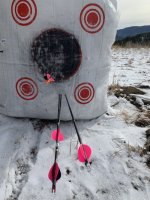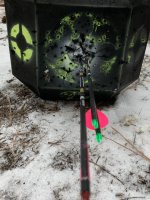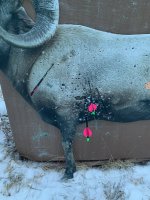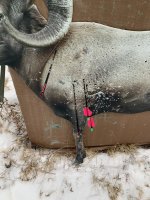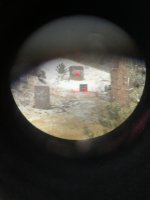I don't disagree with that. But, physics shows you that more drag on the broadhead will slow the broadhead tipped arrow more, you get a lower average speed, more time to cover the same distance, broadhead tipped arrow drops more due to gravity.
Go back to the very first post on this thread and there's some data on it.
Yes, the drag coefficients are the same, however, there is more surface area to act on with the broadhead. Total cross sectional area is greater, no doubt. The arrow whipping back and forth and rotating as it travels downrange will have the greater affect on the BH than FP because of what many call "wind-planing". The math and science is the same for both arrows. Both follow projectile motion equations and at the least, single variable calculus.(this is where all the equations come from, a mathematical representation described over limits of integration).
I may be misreading this, but max velocity doesn’t occur at a certain distance, it occurs right out of the bow.
I can set my LabRadar up to measure the velocity of an arrow five times in the first 100 yards of arrow flight. Regardless of the intervals it will never increase speed after the initial reading.
I forgot who mentioned it, but the cherry picking of groups is the biggest issue most have with people and their groups. Justin always seems to post two arrows stacked on top of each other at some long range, seems as though he has never missed.
My standing challenge is still available for anyone who wants to come out to California and out their set up to the test. Shooting machine and their bow at 20, 60 and 100 yards. I am certain you can get them to hit together at one of those distances but not at all three. FP/BH at 100 together will have the broad head fairly high at 20 and vice versa if they hit together at 20, the broad head will be very low at 100.
Maybe you are misreading this, maybe I wasn't clear. The faster an object is traveling, the more deceleration it will have up to a certain point and then reach a point where it isn't so much as it was initially. So, the most deceleration of any arrow is at time zero right as it leaves the bow system. Initially, drag is almost negligible, but as the arrow travels downrange at time 1 second, 3 seconds, and so forth, drag will begin to take its effect on the broadheads' increased surface area. Eventually, deceleration rate will be fairly close to each arrow, the effects are more pronounced on the broadhead earlier on.
Most of the arrow's velocity where higher deceleration affects it will occur within the first 20 to 40 yards which is why POI can be stated as nearly the same. Nearly the same can be measured by tenths of a inch up to somewhere between one and two inches. Again, no big deal at those distances and FP's and BH's hit the same as you can have that variation with any group with FP's - even with a shooting machine since no two arrows are the same and nobody hunts with just one arrow.
This small variation is compounded downrange at farther distances. The thread title is the about the science and math behind broadheads. My first post on this thread stated the science and math is the same for both arrows because it is, the outcome is variable. My second portion is the realism of most every hunting situation and shot distance that it clearly does not matter because both have the same POI.
The fact about the broadhead hitting lower than the field point at 100 yds is, in general, a moot point. Unless you plan to take animals at 100 yds which opens a whole new "let me get my popcorn" thread...
Are people really dismissing the laws of physics here?
Nope.


